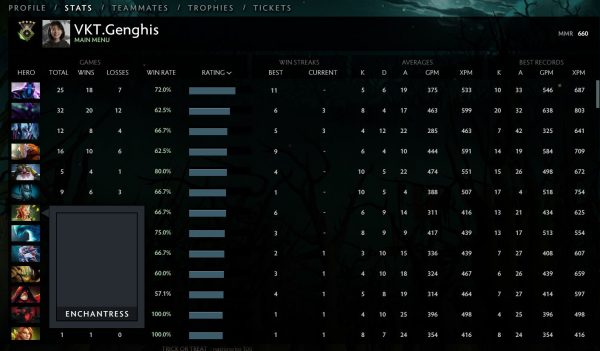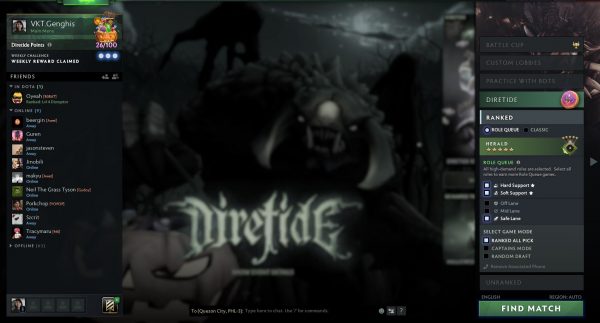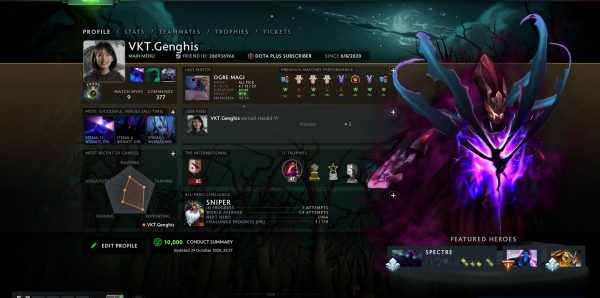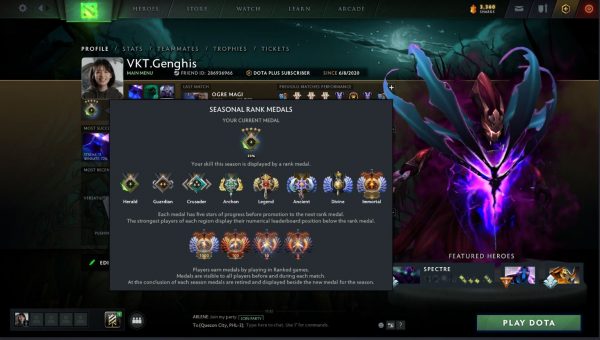What Is Dota 2 MMR?
Hidden behind a player’s medal is a numerical value that Dota 2 calls “matchmaking rating,” or MMR. It is the exact numerical rate of a player’s skill level. One thing to take note of is that, unlike medals, this number will change freely and constantly when players either win or lose games. MMR increases and decreases by approximately 25 points every time players win or lose. Valve stated that Dota 2’s calibration matches won’t give more than 3,500 MMR to fresh accounts. Players who hit this limit need to win games if they wish to climb to the higher ranking tiers. Personal MMR is only available to the player and isn’t seen by other players in the game. Thus, only the same player can watch their MMR, as well as track their progression. Moreover, Valve’s method of putting the players into different leagues that are based on their MMR isn’t revealed to the public and is kept under close guard, in addition to no one outside the company knowing how exactly the MMR is calculated. This system also remembers and judges players based on their peak skill level in-game. Though their current MMR does affect, this is more so that the system can effectively prevent smurfing and de-ranking. While creating a match, Dota 2 considers MMR as the main factor for deciding the players that you’re teamed with, and who you’re fighting. However, this is not the only factor. Also, there are two categories of MMR Rank in Dota 2. If you’re looking for more Dota 2 guides, we have articles to help you out. Here’s our review of the Dota Plus subscription and our Dota 2 Battle Pass Guide.
Normal Dota 2 MMR
This MMR number isn’t seen on your profile. However, it’s stored in the game’s database. It uses this MMR when they’re creating a normal match. Before the latest update, it’s different for core and support MMR. Now it’s divided between all the roles in the game (more on that later). Sometimes this is also referred to as the Hidden MMR
Ranked Dota 2 MMR
This MMR number is prominently displayed on a player’s profile and is used when Dota 2 is creating a Ranked Match for a player. Like the Normal MMR, it’s different between all the roles in the game.
How Does It Affect Your Gameplay?
MMR in Dota 2 is a system created to determine how skilled a player is in the game. However, the system’s main purpose is to look for and pair equal teammates and enemies so that the game is fair for both groups. It’s designed so that players with more experience don’t fight those that are of a lower skill level. All games of Dota 2 fall into two categories: unranked and ranked.
Unranked Game Modes
Unranked games in Dota 2 are games that do not affect a player’s Ranked MMR. These are divided into 10 distinct game modes.
All pick Turbo Ability Draft Single Draft All Random Random Draft Captains Mode Captains Draft Least Played All Random Deathmatch
Meanwhile, Ranked matches are games that allow players the ability to raise or lower their MMR in Dota 2 depending on the result of the match.
Ranked Game Modes
Ranked All Pick – First, players need to vote heroes that they want to ban, up to five heroes per team; then they each take turns choosing what heroes they want to play as that remain on the list. Captains Mode – the captains of each team will alternate in choosing and banning heroes that are in the Hero Pool. Random Draft – a list of 50 heroes is immediately created by the game, and players take turns in choosing the hero they want to play in the match.
How Does DOTA 2 Calculate MMR?
When players begin their first-ever match in a new account, their MMR is given to them randomly. After that, depending on how well you perform in the first match, it’s then taken as a guide while you play the next few matches in the account. Dota 2 will then keep on noting the results and how you perform in all normal matches after. After players have finished 100 hours of gameplay, they can then go and play Ranked. Do note though that a player needs to play 10 calibration matches on all the different player positions to establish the position MMR. After that, the ranked MMR for the position of your choice will become visible on the player profile.
Recent Changes to MMR
On March 2, 2020, Valve added in a patch that shook up how the game calculates player MMR. If before player MMR is judged based on the performance of their Core and Support roles, the current version of Dota 2 has changed that script. It now ensures that all five roles are now given separate, ranked MMR’s of their own, from Position 1 Carries to the Position 5 Hard Supports. Dota 2 is now going to show the real story of how good you’re playing in a specific role.
Medal System
In addition to the MMR changes, there are also changes in how the game presents the Seasonal Rankings, or more commonly known as the MMR Medal System. Before we talk about the changes though, let’s talk about what the Medal System is. Seasonal Rankings show the level of skill that a player has shown on a single game season. This is determined by their MMR as well as other hidden factors. This medal system, however, is only available and upgraded in ranked matches and is reset when a season ends. The medal from the previous season is then displayed beside the new medal that’s given to the players for the current season. There are a few things that players have to remember. First, Valve doesn’t release the exact calculation for MMR ever—and probably won’t release it—and the way they’ll calculate the MMR might change over time. Secondly, the MMR that’s displayed might not always match the estimated medal. However, it’s a normal occurrence that the MMR displayed is off by a few hundred points, so it’s not something to worry about. The third thing to consider is that a player’s MMR isn’t the only determining factor when it comes to medal rank. And finally, there’s a chance that some players have medals that are far above their current MMR. This might be because:
the Player might have more Steam accounts. Dota 2’s system remembers said player’s performance through their peak skill level and not their current skill level. Do note that this is common in competitive games so that they can combat intentional de-rankers and smurfs.
Rank Medals List
There are 11 Rank Medals that one can get in their journey in Dota 2’s Ranking system. These medals are as follows:
Unranked/Uncalibrated
Exactly as it says on the tin. You haven’t dipped your tippy toes on Dota 2’s Ranked Ladder, and you’re probably still learning about the game’s numerous techniques, requirements, and roles. Don’t worry, people aren’t gonna shank you for it in-game. Maybe. The medal icon is gray with a question mark.
Herald
The starting rung of Dota 2’s Ranked Ladder. This, and the Guardian and Crusader Ranks are usually the places where your typical Dota 2 players are. And that’s because most of the time, this is the place where players that party together play. So for people that wish to climb the ranks, it’s best if you just party with people that you trust will do their part in the game. The Herald medal icon is represented by the Tango item and stars corresponding to your MMR rank from 1 to 5.
Guardian
Similar enough to Heralds, Guardians are where most of the people that just want to play Dota 2 because they enjoy Dota 2 go. They party with friends at drunk party pubs, choose heroes that they want to play because they want to play them, et cetera. However, this and the rank above it are also places where people test Hero Builds and other stuff. So you might want to be wary. The Guardian Medal icon is represented by the Buckler item and stars corresponding to your MMR rank from 1 to 5.
Crusaders
The last of the gateway MMR Ranks and a middle ground for people who want to play Dota 2 for fun and those that wish to go the masochism drive to Immortals. Crusaders, like the two ranks before them, are people that want to play Dota 2. However, it’s in this Rank that they might get the nagging temptation to go for a higher, more distinguished rank in their Server. If you want to go and become one of the best, you might need to pick a role that you excel in playing and stick with it. The Crusader Medal icon is represented by the Ring of Aquila and stars corresponding to your MMR rank from 1 to 5.
Archons
The start of the tryhard ranks, more or less. Archons are when you start to attempt to try and get a higher rank. Either that or keep the current rank you’re on so that you can brag to friends about it. Either way, you’re very good at the game and in your chosen role. Not as good as the next ranks, but pretty good. The Archon Medal icon is represented by the Eul’s Scepter of Divinity and stars corresponding to your MMR rank from 1 to 5.
Legend
The gateway from the try-hards to the ultra try-hards. Legend rankers are those that are committed to getting higher ranks no matter the cost. From grinding the game throughout the day to trying out new roles and heroes, expect these guys to do anything and everything to get to the next three ranks. Keep an eye out when you see these guys; some of them might be testing out a build for specific heroes or somesuch. The Legend Medal icon is represented by the Black King Bar and stars corresponding to your MMR rank from 1 to 5.
Ancient
Let’s start talking about the Ancient Rank. Getting here is a chore and a half. Keeping this rank is an exercise in masochism. And getting to the next rank is an absolute nightmare if you have bad luck. This is the beginning of serious mode grinding, playing games all day, every day. And they’re among the most dangerous people to meet in a game due to having the technical know-how to turn the enemies inside out because they want to get to Divine Rank. The Ancient Medal Icon is represented by the Manta Style and stars corresponding to your MMR rank from 1 to 5.
Divine
Congratulations, you’re among the best of the best—in terms of not being on the Leaderboards of your Region. Divines are the ones that managed to rise above the rest of the slurry that is Dota 2’s Ranked System to stand above them as—not as good as the Immortal Rankers but—awesome against everyone else. They know a lot about the game and will not hesitate to use it against their enemies. Do be careful when you meet them in a lobby, you’re bound to get shanked in-game. The Divine Medal Icon is represented by the Divine Rapier and stars corresponding to your MMR rank from 1 to 5.
Immortal
And finally, the last Medal in the game. Immortals are those that are so good in their Region, they got added to their Regional Leaderboards. If you’re playing with these hallowed individuals, make sure to listen to them as they know what they’re doing. If you’re playing against these individuals, best prepare your funeral proceedings as you’re probably screwed. The Immortals rank is further divided based on where you are on the Regional Leaderboard. This leaderboard starts from 5,000 to 1. With the top 1,000, top 100, top 10, and top 1 getting personalized medals that are based on the Aegis of the Immortal as their medal icon, a huge honor.
How to Recalibrate Dota 2 MMR?
Now that we know all this, let’s talk about exactly how you can get to these rankings. But first, what exactly is MMR recalibration?
What Is MMR Recalibration?
Dota 2 frequently calibrates the MMR of all the players based on the game’s current season, and if you want to play competitively, you need to ensure that you play well. Because Dota 2 will constantly update itself with a new season (this new season update usually occurs every six months), the game will also reset the rankings of all players and have them recalibrate their MMR Rank. Now calibrating your profile’s rank is easy; you only need to play 10 ranked matches. However, If you want to know how to recalibrate your rank, here’s a step-by-step guide on doing so.
Step-by-Step Guide
As we’ve already mentioned, Dota 2 resets the MMR of all players twice a year, it’s during these times when Player MMRs are being reset that you have a chance of getting higher rankings. And the process is pretty simple. One thing that you need to take into account is that the game does take a look at the rank you have on the previous season as a baseline. However, this is more to check if you got better or worse when compared to your previous rank, nothing more, nothing less.
How to Earn or Get More Dota 2 MMR?
Now getting more MMR in Dota 2 is both an easy and hard endeavor because you only need to do one thing. Play, and play well. That’s it. And you need to do it on Ranked Matches. There are two ways to do so. You can do it alone, or you can do it at a party. And there’s a very stark difference between the two. Looking to get more MMR, why not sign up to a Dota 2 coaching platform? Here’s our review of GameLeap and if it’s worth subscribing to.
Solo Queue
This is the place where you go at Dota 2’s ranked ladder alone. You’re a man against the world itself, and you will prove that you’ve got the chops to become one of the best. You will have to make sure that you have the mental fortitude to continue. Solo Queue is usually a mix of players. One time you can get paired with a team of hypercompetent teammates that crush the opposing team, other days you’ll get amateurs. However, climbing the Solo Queue is possible and incredibly hard. And sometimes, it’s not because of you but because of those that you got teamed with.
Party
Now if you’re not in the mood to put yourself in that masochism sphere, you can play with friends. At least this time you have a good know-how on their capabilities and prowess in the game. Also, it’s way more fun to play when you’re with people that suffer with you when queuing, so there’s that.
Why Increasing Dota 2 MMR Is Good for Players?
Increasing your MMR is a good thing because it shows you exactly how good you are. It gives you a metric so that you know where you stand. Plus, if you want to get better, you immediately know as well. The one thing that allows you to get better MMR, is to constantly improve yourself in the game. That’s it. So buckle up, and good luck.





